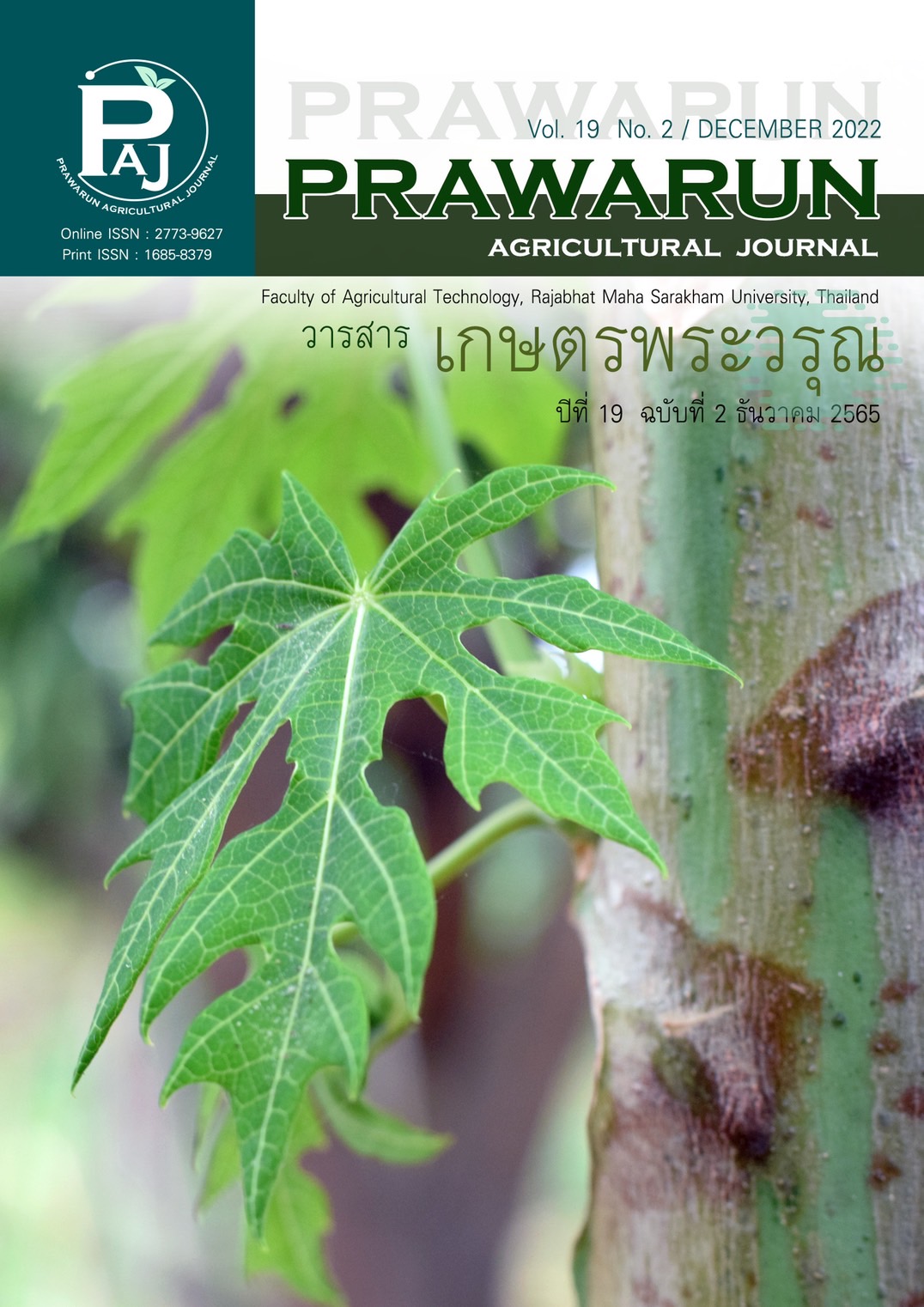ผลของการใช้แป้งข้าวหอมนิลทดแทนแป้งสาลีต่อคุณภาพของชิฟฟ่อนเค้ก
Main Article Content
บทคัดย่อ
งานวิจัยนี้มีวัตถุประสงค์เพื่อศึกษาผลของการใช้แป้งข้าวหอมนิลทดแทนแป้งสาลีต่อคุณภาพของชิฟฟ่อนเค้กโดยได้ทดแทนแป้งสาลีด้วยแป้งข้าวหอมนิลที่ร้อยละ 10 20 30 40 50 และ 60 โดยน้ำหนักแป้งสาลี ผลการศึกษาคุณภาพทางกายภาพ เคมี และจุลินทรีย์ พบว่า ค่า a* (ด้านในของเค้ก) ค่า Hardness ค่า Adhesiveness ค่า Springiness ค่า Gumminess ค่า Chewiness ปริมาณแอนโทไซยานินรวม และฤทธิ์การต้านอนุมูลอิสระของชิฟฟ่อนเค้กเพิ่มขึ้นตามปริมาณการทดแทนที่เพิ่มขึ้นของแป้งข้าวหอมนิล ในขณะที่ค่ากิจกรรมน้ำอิสระ ค่า L* a* b* (เปลือกนอกของเค้ก) ค่า L* b* (ด้านในของเค้ก) ค่า Cohesiveness และ ค่า Resilience ของชิฟฟ่อนเค้ก ลดลงตามปริมาณการทดแทนที่เพิ่มขึ้นของแป้งข้าวหอมนิล แต่อย่างไรก็ตาม ค่าน้ำหนัก ค่าปริมาตร ปริมาณความชื้น ปริมาณแบคทีเรียทั้งหมด และปริมาณยีสต์และราของชิฟฟ่อนเค้ก ไม่เปลี่ยนแปลงตามปริมาณการทดแทนที่เพิ่มขึ้นของแป้งข้าวหอมนิล ผลการประเมินทางประสาทสัมผัส พบว่า ชิฟฟ่อนเค้กทดแทนด้วยแป้งข้าวหอมนิลร้อยละ 10 - 60 ได้รับการยอมทุกด้านที่ทดสอบอยู่ในระดับชอบปานกลางถึงชอบมาก มีคะแนนการยอมรับอยู่ระหว่าง 6.90 - 7.83 ดังนั้นชิฟฟ่อนเค้กข้าวหอมนิล สามารถพัฒนาเป็นอาหารทางเลือกที่มีส่วนประกอบของสารออกฤทธิ์ทางชีวภาพและมีฤทธิ์การต้านอนุมูลอิสระ
Article Details
เอกสารอ้างอิง
Association of Official Analytical Chemists (AOAC). (2000). Official methods of analysis (17th ed.). Arlington, Virginia: Association of Official Analytical Chemists.
Association of Official Analytical Chemists (AOAC). (1995). Official methods of analysis (16th ed.). Washington, D.C.: Association of Official Analytical Chemists.
Chodnakarin, A., Phugan, P., Inket, S., Sam-ang, P., & Jansukon, E. (2021). Effects of wheat flour substitution with Hom Nin broken rice flour on quality changes of brownie. Christian University Journal, 27(1), 85-96.(in Thai)
Daiponmak, W., Senakun, C., & Siriamornpun, S. (2014). Antiglycation capacity and antioxidant activities of different pigmented Thai rice. International Journal of Food Science & Technology, 49(8), 1805-1810. doi:10.1111/ijfs.12487.
Kapcum, C., Uriyapongson, S., & Uriyapongson, J. (2021). Phenolics, anthocyanins and antioxidant activities in waste products from different parts of purple waxy corn (Zea mays L.). Songklanakarin Journal of Science & Technology, 43(2), 398-405.
Kitisin, T., Saewan, N., & Luplertlop, N. (2015). Potential anti-inflammatory and anti-oxidative properties of Thai colored-rice extracts. Plant Omics Journal, 8(1), 69-77.
Lee, J., Durst, R. W., Wrolstad, R. E., Barnes, K. W., Eisele, T., Giusti, M. M., Hache, J., Hofsommer, H., Koswig, S., Krueger, D. A., Kupina, S., Martin, S. K., Martinsen, B. K., Miller, T. C., Paquette, F., Ryabkova, A., Skrede, G., Trenn, U., & Wightman, J. D. (2005). Determination of total monomeric anthocyanin pigment content of fruit juices, beverages, natural colorants, and wines by the pH differential method: collaborative study. Journal of AOAC international, 88(5), 1269-1278.
Mau, J. L., Lee, C. C., Chen, Y. P., & Lin, S. D. (2017). Physicochemical, antioxidant and sensory characteristics of chiffon cake prepared with black rice as replacement for wheat flour. LWT - Food Science and Technology, 75(1), 434-439. doi: 10.1016/j.lwt.2016.09.019.
Prateepdolpreecha, T. (2018). Study of the effect of brown rice: Khao Hom NiL on blood uric acid level (Master’s thesis). Bangkok: Dhurakij Pundit University. (in Thai)
Rattanachak, N., Pankerdphon, A., Sam-ang, P., Rugchati, O., Sanphom, T., & Chodnakarin, A. (2019). Development of healthy soy milk product by using sucralose and Hom Nin broken rice. The Science Journal of Phetchaburi Rajabhat University, 16(2), 49-59. (in Thai)
Rodmui, A., & Jitwaropas, O. (2007). Production of cookies using wheat flour partial substituted with Hom Nin rice flour. Journal of Food Technology, Siam University, 3(1), 37–43. (in Thai)
Sadabpod, K., Tongyonk, L., & Kangsadalampai, K. (2014). Effect of Hom Nil rice and black glutinous rice extracts during treatment of chicken extract with sodium nitrite using ames test. Songklanagarind Medical Journal, 32(3), 139-149. (in Thai)
Sangnark, A., Limroongreungrat, K., Yuenyongputtakal, W., Ruengdech, A., & Siripatrawan, U. (2015). Effect of Hom Nil rice flour moisture content, barrel temperature and screw speed of a single screw extruder on snack properties. International Food Research Journal, 22(5), 2155-2161.
Sanon, W., & Sangteerakij, D. (2020). Development of products from Khanom A-lua Homnil rice flour supplemented with butterfly pea water extract. VRU Research and Development Journal Science and Technology, 15(3), 37-51. (in Thai)
Sirichokworrakit, S., Intasen, P., & Angkawut, C. (2016). Quality of donut supplemented with Hom Nin rice flour. International Journal of Nutrition and Food Engineering, 10(7), 443-446.
Srisorn, P., Boontaganon, P., Sopanangkul, A., & Terapatponchai, Y. (2020). The optimum condition of pre-gelatinized Hom Nil rice flour production by using double drum dryer. RMUTSB Academic Journal (Humanities and Social Sciences), 8(2), 199-214. (in Thai)
Sutharut, J., & Sudarat, J. (2012). Total anthocyanin content and antioxidant activity of germinated colored rice. International Food Research Journal, 19(1), 215-221.
Thiranusornkij, L., Thamnarathip, P., Chandrachai, A., Kuakpetoon, D., & Adisakwattana, S. (2018). Physicochemical properties of Hom Nil (Oryza sativa) rice flour as gluten free ingredient in bread. Foods, 7(10), 159. doi: 10.3390/foods7100159.
Wattanuruk, D. (2017). Production of germinated brown rice drinking yoghurt. The Golden Teak : Science and Technology Journal, 4(2), 13-21. (in Thai)


